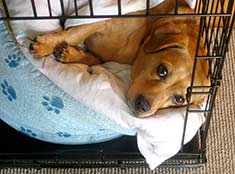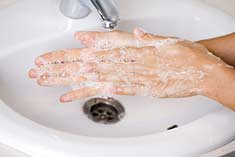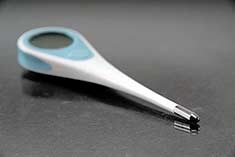First Aid for Your Dog
We all know veterinarian visits can be expensive, but at the same time we all want to provide the best care possible for our dogs. How do you know when to treat at home and when to go to the vet? What do you need to keep on hand to take care of your dog at home?

Vet visit required
Although you may want to keep your dog at home where he is most comfortable, there are certain situations where you will want to seek professional help. The Emergency Veterinary Clinic of Cincinnati recommends that you take your dog to the vet immediately if you observe any of the following conditions:
- • your dog is having trouble breathing, is making more noise than usual while breathing, is gasping for breath, or has a blue tongue.
- • you cannot get bleeding to stop by applying pressure to a wound.
- • your dog's abdomen is swollen or painful.
- • your dog cannot pass urine or stool, even though he is trying to.
- • your dog whines in pain when he is going to the bathroom.
- • you find blood in the stool or urine.
- • your dog has heatstroke, indicated by heavier-than-normal panting, coupled with extreme weakness and a rectal temperature above 104 degrees.
- • your pregnant dog is having contractions for longer than an hour without delivering a pup, or the dog is in labor for more than 15 minutes after part of the fetus or its membranes are already showing.
- • your dog loses consciousness or has a seizure. This can be indicated by tremors, coma, staggering, convulsions, sudden blindness, biting at imaginary objects, or sudden change in personality.
- • your dog experiences severe or continuous pain.
- • your dog experiences any major trauma such as falls, vehicle accidents, large cuts, puncture wounds, especially in the chest or abdomen, or broken bones.
- • your dog collapses, begins breathing more shallowly, looks more bewildered than normal, or has dilated pupils or a rapid heartbeat.
- • your dog eats anything poisonous. (Take the container with you.)
- • your dog cannot bear weight on any of his legs, if rest, aspirin, and/or ice does not resolve the issue.
- • your dog has a severe itch, such that he is tearing at his skin to try to relieve it.
What first aid measures can I try at home?
Assuming your dog is not experiencing one of the emergencies listed above, you can try some common sense first aid measures to treat your dog at home. No matter what the problem, it is important that you stay calm in order to keep your dog calm. Wash your hands both before and after treating your dog to assure that no infections are passed between the two of you. If you are treating multiple dogs, wash your hands between dogs.
If your dog is bleeding from a minor cut, apply pressure with a clean cloth. Once the bleeding is stopped, apply an anti-bacterial ointment. Watch the area for signs of infection, and continue applying the ointment until the skin heals. If you see signs of infection (redness, warmth, swelling, or excessive pain, you will need to seek the help of a veterinarian.
For strains and sprains, wrap the affected limb in an ace bandage and keep the dog quiet. For most dogs, this will require you to confine the dog to a small area like a crate or even a small bathroom. If the dog is not able to bear weight on the limb after a day or two of rest, it may be worth taking the dog in for an X-ray to make sure nothing is broken.
If your dog is experiencing diarrhea, try giving Pepto-Bismol or Kaopectate to slow down his GI tract. It is also important to temporarily reduce the amount of fat in his diet until his system is under control. The best diet for diarrhea is cooked rice and boiled chicken. You may want to feed your dog several small meals a day, rather than his normal one or two. Your dog will think he has died and gone to heaven!

For itchy ears, a simple cleaning may be enough to relieve your dog's misery. Using cotton balls soaked in rubbing alcohol or hydrogen peroxide, reach as far into the dog's ear canal as possible and swab out the ear. The shape of the ear canal will prevent you from reaching or harming the dog's ear drum. Repeat the process several times until the cotton balls come out clean. If you have to continually clean the ears for several days, you may need to have the dog checked for mites or infection.
One cause of itchy ears can be a yeast infection, caused by excessive moisture in the dog's ear canals. If you bathe your dog at home, make sure you dry his ears as much as possible, particularly if he has heavy ears that hang down and can trap moisture.
If your dog is bitten by an insect or stung by a bee, a simple antihistamine will keep him from getting too miserable. Be aware that this will also make your dog very sleepy, so don't be alarmed if he sleeps more than usual after taking this remedy.
For any type of pain, buffered aspirin is a good first line of defense. Do NOT give your dog acetaminophen (Tylenol), as this can cause liver damage.
What should I keep in a dog first aid kit?
Many of the things you need for a dog first aid kit are the same as the things you likely keep on hand for your human family. Buffered aspirin, antihistamine, stomach / diarrhea medications, ace bandages, hydrogen peroxide, rubbing alcohol, and cotton balls can be shared by all members of the family, regardless of whether they have two legs or four.

Some things you might want to have on hand in addition to the above include a muzzle, and a rectal thermometer. Many dogs become agitated when they are hurt. If you probe at the area of the injury, it is very likely your dog will react out of instinct, which may include biting you. Even if your dog is a cupcake normally, it's not worth the risk. Putting a muzzle on him for the few seconds it takes to treat an injury will not harm the dog and will provide adequate protection for you.
A rectal thermometer is vital, as fever is an important indicator of a problem. A temperature above 104 degrees Fahrenheit is cause for concern. If your dog has a minor fever (normal is between 101 and 102), try giving him a buffered aspirin and take his temperature again in one hour. If the fever continues to rise or gets above 104, a vet visit is warranted.
Finally, keep your dog's medical records with your first aid kit. This should include documentation of all shots, as well as information about any medical conditions your dog has and any medications he is taking.
Doggies Den: Latest Articles
 Homemade Thanksgiving Treats for Your Dog
Homemade Thanksgiving Treats for Your Dog
NUTRITION We all want to include our dogs in our holiday celebrations, but hopefully, you're aware that sharing table scraps with your dog isn't always the best idea.
 Keeping Your Dog Safe during the Summer Months
Keeping Your Dog Safe during the Summer Months
HEALTH Summer is coming on fast, so it’s time to plan how you will keep your dog safe and healthy through the lazy, carefree, warm days.
 Vaccination Time Again-Keeping Your Puppy Healthy
Vaccination Time Again-Keeping Your Puppy Healthy
DOG HEALTH So you have your new puppy picked out. There are quite a few shots, treatments and examinations that will keep the newest member of your family healthy.
 Canine Thanksgiving Feast
Canine Thanksgiving Feast
NUTRITION With the wide variety of food at Thanksgiving dinner, chances are you'll want to give your dog something special, too. If you're contemplating what to feed your dog for the holiday, here is a guide to a great Canine Thanksgiving Feast.
 Dog Walking Tips Every Owner Should Know
Dog Walking Tips Every Owner Should Know
DOG FUN Walking your dog is not only crucial to keeping him healthy and happy, it strengthens the bond between your canine friend and his caregiver. There are a lot of obstacles out there. Don’t forget these simple tips to keep your walk fun and safe in the outside world.
 The Benefits of Physiotherapy for your Dog
The Benefits of Physiotherapy for your Dog
HEALTH The same techniques that physiotherapists use to treat a variety of injuries and conditions in humans have been adapted to suit animals with great success. Family pets, show dogs, and working dogs can all benefit greatly from physiotherapy. Dogs whose activities involve a lot of agility are especially susceptible to the types of problems that physiotherapy can address.
 The Decision- Adding a Dog to Your Family
The Decision- Adding a Dog to Your Family
FIRST TIME OWNERSBringing a dog into your family is a decision where many people don’t realize it’s magnitude until after they have the dog. There are a number of things that you need to research before you decide to purchase a dog, and it starts right in your own home.
 Bringing Your Dog Into Your New Baby's Life
Bringing Your Dog Into Your New Baby's Life
HEALTH Many believe that a dog and a new baby cannot happily coexist, so therefore the dog has to go. This is not necessarily the case.  A new baby does not mean you have to abandon your dog.

Doggies Den:
Most Popular Articles

Dog Pregnancy Symptoms
HEALTHIf you suspect your dog might be pregnant, check out part one in this series on pregnant dogs, where we cover pregnant dog symptoms.

Dog Birth
HEALTHIn the third article of our dog pregnancy series, we look at the wonderful, but messy, process of bringing newborn puppies into the world.

Indoor Dog Potties
DOG PRODUCTSIt's been a long day at work. You were so busy, you didn't even take time to eat a sandwich, let alone run home to let your dog out. You're on your way home, knowing the poor dog is crossing his or her legs by now, when your car breaks down, delaying you even further. Can't somebody make this easier?

Your Dog’s Digestive System
PHYSIOLOGYEver wonder why your dog eats so fast? Or why he eats gross things? Or why he gets sick to his stomach? Or why his waste stinks so bad? Some of these things are normal, some are not.

Canine Respiratory System
BREATHINGThe basic function of your dog's respiratory system is to bring oxygen in to and remove carbon dioxide from the body. Knowing the symptoms of respiratory diseases can help you help your stay healthy.

Shelter Dog Adoption Tips for Success
ADOPTION Are you intimidated by the prospect of "rescuing" a dog from a shelter? One reason that you may be wary of adopting a dog from a shelter is not knowing how to choose. Adopting a dog from a shelter can be a rewarding process, if you're prepared to do a reasonable amount of research.

Canine Urinary Tract Infections
SYMPTOMS AND TREATMENTDoes your dog seem to be having trouble relieving his or her bladder? Learn how to recognize the signs of urinary tract infections and how to treat them before they spread.

What to do for Dog Diarrhea
SYMPTOMS AND REMEDIESIf you have dogs in your house for any length of time, you have likely experienced at least one bout of dog diarrhea. Beyond the pain in the tuckus involved in cleaning up the mess, you should know what causes diarrhea, and when it's important to see the vet.

What to do for a Dog Bite
DOG BEHAVIOR Getting bitten by a dog can be scary, and you may be tempted to run around in circles for a while, trying to figure out what to do. Here's our guide to help you manage the situation.

Top Ten Tips for Living with a Senior Dog
DOG HEALTH Bringing home a new puppy is so exciting, but it doesn’t take all that long for your exuberant puppy to grow into a senior dog who may have special needs. Here are the doggies.com top ten tips for taking care of your companion who has been with you through so much.
